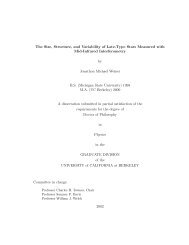Problem Set #2 1. Problem 4.15 Suppose a constant force of ...
Problem Set #2 1. Problem 4.15 Suppose a constant force of ...
Problem Set #2 1. Problem 4.15 Suppose a constant force of ...
Create successful ePaper yourself
Turn your PDF publications into a flip-book with our unique Google optimized e-Paper software.
where dz is the width <strong>of</strong> the reference frame and g 0 is the Newtonian gravitational<br />
acceleration at the point <strong>of</strong> closest approach, O. The angular deflection is small,<br />
so assume that the photon is initially traveling in the z-direction as it enters the<br />
frame. (Hint: The width <strong>of</strong> the frame in the z-direction is dz, so the time for<br />
the photon to cross the frame can be taken to be dz/c)<br />
(b) Integrate the result you found in part (a) from α = −π/2 to +π/2 and so find the<br />
total angular deflection <strong>of</strong> the photon as it passes through the curved spacetime<br />
near the Sun.<br />
(c) Your answer (which is also the answer obtained by Einstein in 1911 before he<br />
arrived at his field equations) is only half the correct value <strong>of</strong> <strong>1.</strong>75”’. Can you<br />
qualitatively account for the missing factor <strong>of</strong> two?<br />
4. <strong>Problem</strong> 17.9 Consider a spherical blackbody <strong>of</strong> <strong>constant</strong> temperature and mass M<br />
whose surface lies at radial coordinate r = R. An observer located at the surface <strong>of</strong><br />
the sphere and a distant observer both measure the blackbody radiation given <strong>of</strong>f by<br />
the sphere.<br />
(a) If the observer at the surface <strong>of</strong> the sphere measures the luminosity <strong>of</strong> the blackbody<br />
to be L, use the gravitational time dilation formula:<br />
∆t 0<br />
= v (<br />
∞<br />
= 1 − 2GM ) 1/2<br />
∆t ∞ v 0 r 0 c 2 (4)<br />
to show that the observer at infinity measures<br />
(<br />
L ∞ = L 1 − 2GM )<br />
Rc 2 . (5)<br />
(b) Both observers use Wien’s law<br />
λmaxT = 0.002897755 m K, (6)<br />
to determine the radius <strong>of</strong> the spherical blackbody. Show that<br />
T ∞ = T<br />
(c) Both observers use the Stefan-Boltzmann law,<br />
√<br />
1 − 2GM<br />
Rc 2 . (7)<br />
L = 4πR 2 σT 4 e , (8)<br />
to determine the radius <strong>of</strong> the spherical blackbody. Show that<br />
R ∞ =<br />
R<br />
√<br />
1 − 2GM/Rc 2 . (9)<br />
Thus, using the Stefan-Boltzmann law without including the effects <strong>of</strong> general<br />
relativity will lead to an overestimate <strong>of</strong> the size <strong>of</strong> a compact blackbody.<br />
2













![Problem #1 [Structure Formation I: Radiation Era]](https://img.yumpu.com/37147371/1/190x245/problem-1-structure-formation-i-radiation-era.jpg?quality=85)


